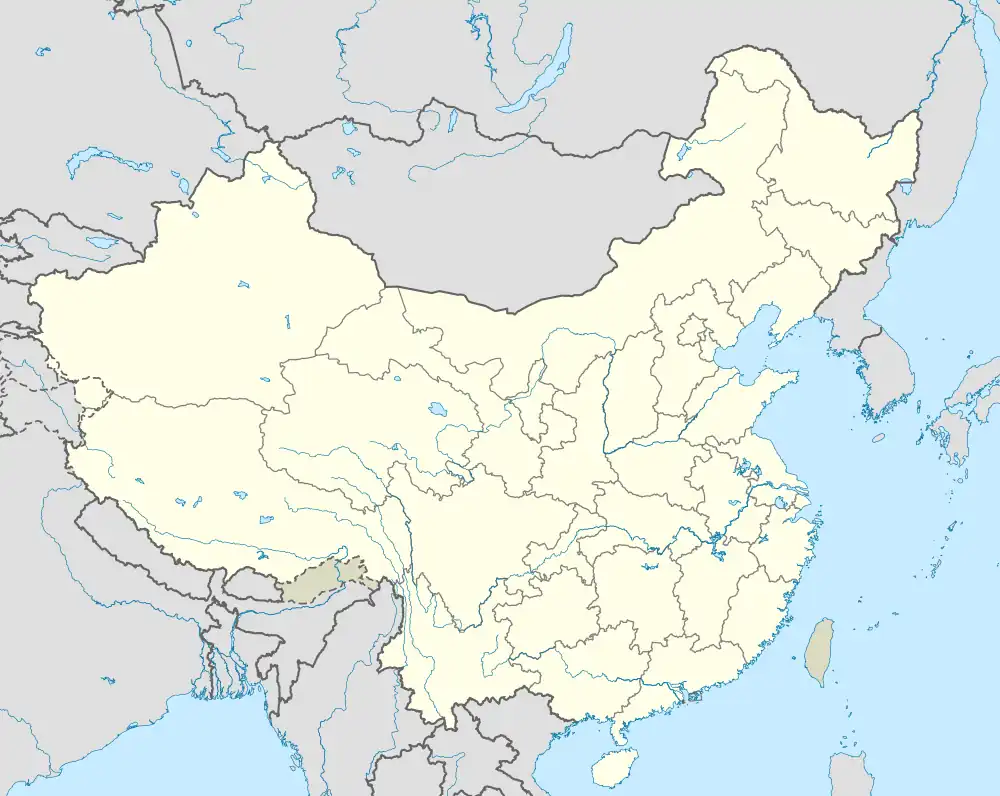Yanhewan
Yanhewan (simplified Chinese: 沿河湾镇; traditional Chinese: 沿河灣鎮; pinyin: Yánhéwān Zhèn), is a town in Ansai District, Yan'an, Shaanxi, China.[2] The town spans an area of 210.92 square kilometres (81.44 sq mi).[1] According to the 2010 Chinese Census, Yanhewan has a population of 14,499.[3]
Yanhewan
沿河湾镇 | |
|---|---|
 Yanhewan | |
| Coordinates: 36°45′08″N 109°22′04″E | |
| Country | China |
| Province | Shaanxi |
| Prefecture-level city | Yan'an |
| County | Ansai District |
| Area | |
| • Total | 210.92 km2 (81.44 sq mi) |
| Population (2010) | |
| • Total | 14,499 |
| • Density | 69/km2 (180/sq mi) |
History
Dynastic China
In the early 7th century, during the Tang dynasty, the urban center of Jinming County (simplified Chinese: 金明县; traditional Chinese: 金明縣; pinyin: Jīnmíng Xiàn) was located in present-day Diezigou Village in Yanhewan.[4]
During the Song dynasty, Ansai Fort (Chinese: 安塞堡; pinyin: Ānsāi Bǎo) was built in the ancient city of Ansai, located in present-day Yanhewan.[4]
Second United Front
On September 12, 1937, according to an order from the Shaanxi-Gansu-Ningxia Border Region Government, Ansai County, which governed the region including Yanhewan, was re-organized into 7 districts governing 42 townships.[4] One such district was Yanhewan, which governed six townships, including the eponymous Yanhewan township.[4]
People's Republic of China
In March 1956, Ansai County's districts were re-organized, and Yanhewan District was abolished, replaced with the directly administered township of Yanhewan.[3]
In September 1958, Yanhewan became a people's commune, and was renamed to Hongqi (Chinese: 红旗; lit. 'red flag').[3] In September 1961, Ansai County was re-established, and Yanhewan was placed under its jurisdiction.[3] In December 1983, the people's communes were abolished, and Yanhewan was established as a town.[3]
Administrative divisions
Yanhewan administers the following 15 administrative villages:[5]
- Yanhewan Village (Chinese: 沿河湾村)
- Majiagou Village (Chinese: 马家沟村)
- Diezigou Village (Chinese: 碟子沟村)
- Baijiagou Village (Chinese: 白家沟村)
- Lijiawan Village (Chinese: 李家湾村)
- Fangjiahe Village (Chinese: 方家河村)
- Zhaiziwan Village (Chinese: 寨子湾村)
- Yanjiawan Village (Chinese: 闫家湾村)
- Hougoumen Village (Chinese: 候沟门村)
- Yunping Village (Chinese: 云坪村)
- Chafang Village (Chinese: 茶坊村)
- Liudang Village (Chinese: 刘党村)
- Bianqiang Village (Chinese: 边墙村)
- Jiajiawa Village (Chinese: 贾家洼村)
- Gaojiamao Village (Chinese: 高家峁村)
Demographics
According to the 2010 Chinese Census, Yanhewan had a population of 14,499 in 2010.[3] This is down slightly from the 15,245 recorded in the 2000 Chinese Census.[3]
Transportation
The G65 Baotou–Maoming Expressway passes through Yanhewan, and it forms a junction with the terminus of the Yanwu Expressway in Yanhewan.[6]
References
- 中国县域统计年鉴·2019(乡镇卷) (in Chinese). Beijing: 中国统计出版社, 国家统计局农村社会经济调查司. May 2020. p. 616. ISBN 9787503791390.
- 2020年统计用区划代码(安塞区) [2020 Statistical Division Codes (Ansai District)]. www.stats.gov.cn (in Chinese). National Bureau of Statistics of China. 2020. Archived from the original on 2021-06-03. Retrieved 2021-06-06.
- 安塞区历史沿革(第二页) [Ansai District Organizational History (Page 2)]. www.xzqh.org (in Chinese). 2016-07-15. Archived from the original on 2021-06-06. Retrieved 2021-06-06.
- 安塞区历史沿革(第一页) [Ansai District Organizational History (Page 1)]. www.xzqh.org (in Chinese). 2016-07-15. Archived from the original on 2020-01-19. Retrieved 2021-06-06.
- 2020年统计用区划代码和城乡划分代码(沿河湾镇) [2020 Statistical Division Codes and Urban-rural Division Codes (Yanhewan)]. www.stats.gov.cn (in Chinese). National Bureau of Statistics of China. 2020. Archived from the original on 2021-06-06. Retrieved 2021-06-06.
- Li, Hua (2013-12-20). 陕西延安至吴起高速公路通车 [Shaanxi Yan'an to Wuqi Expressway opens to traffic]. www.chinanews.com (in Chinese). China News Service. Archived from the original on 2021-06-05. Retrieved 2021-06-05.